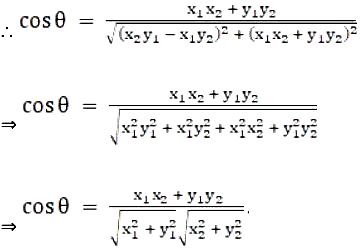To prove:
tan θ = \(\frac{x_2y_1 - x_1y_2}{x_1x_2 + y_1y_2}\) and cos θ = \(\frac{x_1x_2 + y_1y_2 }{\sqrt{x_1^2 + y_1^2 }\sqrt{x_2^2 + y^2_2}}\)
Assuming:
A (x1, y1) and B (x2, y2) be the given points and O be the origin.
Explanation:

Slope of OA = m1 = y1x1
Slope of OB = m2 = y2x2
It is given that θ is the angle between lines OA and OB.

Now, As we know that cos θ = \(\sqrt{\frac{1}{1+ tan^2θ}}\)
